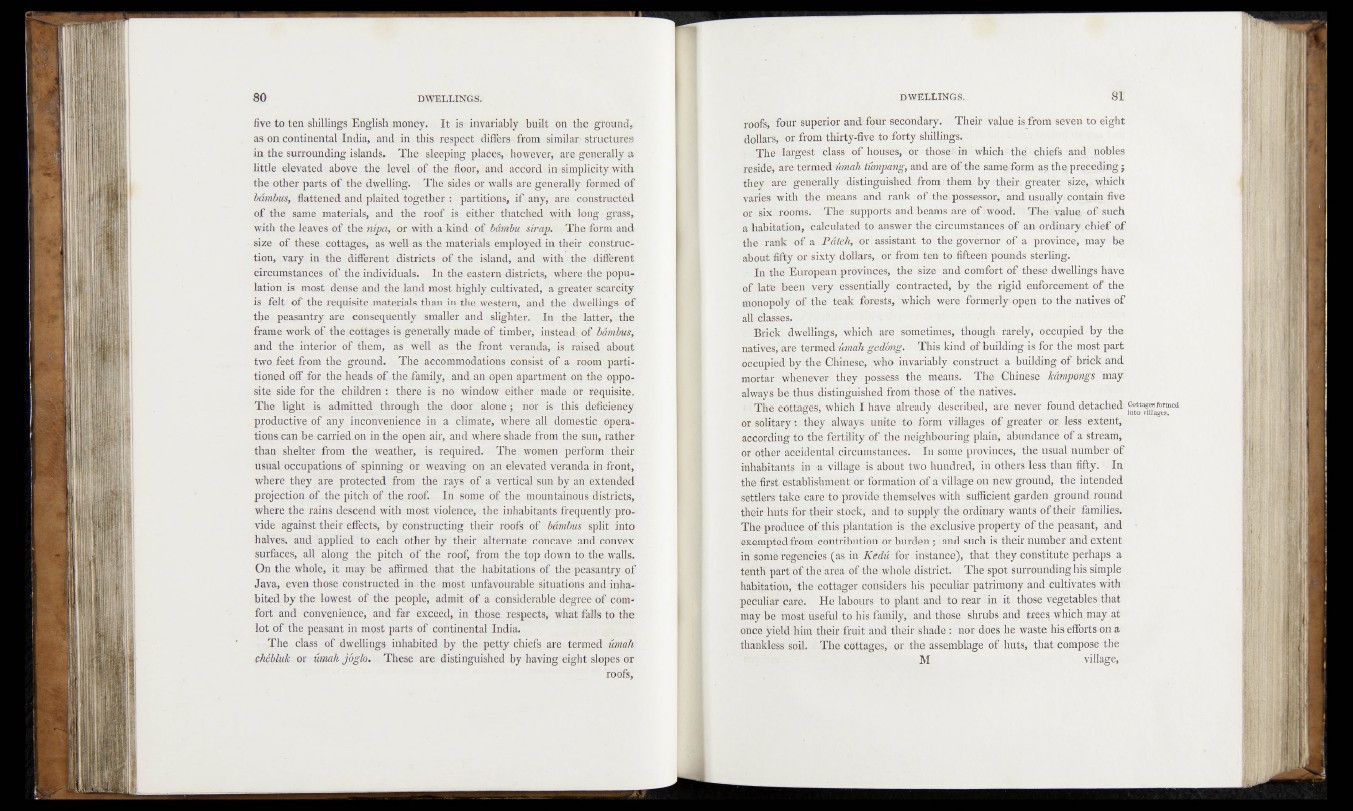
five to ten shillings Englishjmoney. . If&dsf invariably- built',bnithe--' ground,
as on continental India,. and in this respect differs-' from- similar» structures
in the surrounding,islands. The; sleeping places,; however, are.generally a
little elevated above, th.e;- levelxof- the -floor, and accord• in-simplicitywith
the-other parts of the dwelling. The . sides or walls are-generally- formed' of
bombus, flattened, and. plaited, together-: partitions, if-any, are-constructed
of ;tbn. sftffie materials, and the roof is. either-'thatchfed. with long-grass;
with the leav.es of ,the'nipa,- or .with a kind of bâmbu strap. The-form.and
size of these. cottagés; as well as-the materials employed in their - construe-'
tion, .vary in. the different. districts ,of-the island,rand with the,‘different
circumstances, of - the individuals. In -the - eastern- districts, where 'the.popUï
la'tion, is most'.dense and the land most highly cultivated, a greater scarcity
is 2 felt of the., requisite,materials than in.the western, and the- ;d wellingSr.Of
the peasantry are consequently smaller and, slighter. v I n ' l a t t e r , - t h e
frame work of the .cottages is -generally, made of timber,- instead;.of. bombus,
and the interior of them, as well1 as the ftdni veranda,-., is - raised ; about
two,feet from the ground. The accommodations consist- of a-roQUï.- partitioned
off for the heads; of>the:,family, and an open apartments on, ' "opposite,
side for the- children: there is-no window either maiden -or-requisite.
The light is admitted through; the door, alone; nor is this ^deficiency
productive,of-any .inconvenience du a climate, wfie^jfd aU/ddmestic operation
s_can bfe.carried.on in the open air, and_\vhe_re shade Trom., the,isun, rather
than.-shelter-from-the weather, is-required. Thfe-women perform. their
usual occupations of spinning or weaving on an-elevated véranda in front,
where they .are protected from the rays of a vertical sun .by, ah extended
projection of .the pitch of the roof. In - some -of the mountainous districts,
where the rains, descend with-most violence, the- inhabitantsffrequentlyrpro-'
vide against their effects, by constructing their roofs of bombus split into
halves, ■ and applied to each other by their alternate, concave and h’ÔhVèX
surfaces, all along the pitch of the roof, from the .top down to the walls.
On the whole, it may be affirmed that thehabitations : of the peasantry-of
Ja.va, even those constructed in-the.- most unfavourablé situations and1 inhabited
by the-lowest of the people, admit of a considerable degree of comfort
and convenience, and far exceed, in those respects, what falls to the
lot .of the peasant in most parts of continental India.
- The , class of dwellings.', inhabited ; by. the - petty chiefs are ; termed wmah
ckébluk or umah jóglo. --- These are distinguished by having- eight slopes or
roofs,
roofs; ifour superior andjfoür tsecóndary. ■ .uTheif- valudus from seven to eight
Hollars, J or-i from-thirt^^fivé-Ioffdrty^JsHi^liJlgs., ;
• The' 'largest class of 'nBusés^ or v'-t-hos^in-1 which’•*the.* chiefs land; jnoblep
iesidejfarêïféfmedïémaRltifonpc^tfafodu are > ofithe sam'^fórm-’as; thd preceding;
•-tllè^ÉfEêirgenerally distinguished Tromu them, by. theirt1 great-en.lsiJe.’t which
dailies with;thé ’mean's rand rankofIthe:possessor, ^and usuallyifconfcjtón.five
orosix^rooms.- -Thé«supportsfafadfoeams;ai^io^^od^,^^fe^a.hieji<r>^such.
adiabitatjori, Icafeulatedftbaanswër thé circumstaffce^c® ahJordmaryichiOfi.of
tfié.-rarik’ iof a Pdteh,'M$ assistant tot!the'goyéttfor^öïéai pf^vin'cé,:"^nay' -he
abhtc^ fifty“ojïsi^tjr dbllar-s.^orlfrom ten tot-fifteen pounds sterling.
In the'®uröpjéan provinces; Ifche'.'éize and*eómfoff o£r.these\dwellingsi>have
ófolat"é^.b|êmétery':éss.tnt-j.#l^ppntracted;' by^therrigid ^enforcement<of the
feonopblymlP' -the teak- foifests,'%hicKf1p?eres formerly'open- to the natives-of
all [’classes. ■;
• Brické'dwenings^wh'fcH'^ne'^s^élim^'^foough ray,è’ly,f óècépiëd^by^he,
natives,'■are gedhng. - This-flÉntteof hüildingus for 'the most part,
ollfipïédj by-the -Chinesep^Whó inivaria'bly t'thi^tES'cfera'ïb'uÜdln-g -ceft'bück and
mortar -w l^ é v ^ th e '^ ^ ^ é s s ? theumeans. TJt'er.fëhinesO- Mmppngs, may
-al waystbë'ifi^^isttn^ÖM'èd 'fromfiHösë$£ the natitf'swy*
! i The^ccftt%eS^me^Biave‘ already-dêsGribëÜ,^are. never found hetaeKd^j^i^^raed
6msblitarvy :>th'èy.^aLwaysB.U!nite.r-tooförm - villages • "èf fgrfeafer-öry lfSsfSfextent,»
é'cÖOTdingltb%wf^^tól^^^^®®*-neigbbouring plain, aliutidancmÖt a*stream;1
•Jwijh'er.’ac'cidentab’circumstaiïaOStb In §Snfe%mvihees> ittfe^ugual number*of
inhabitant' jn^atyilMge.ds(about two hundred, in otheglHlss -than fifty. In
the^firstfostablisbmehtr'oLformation <fÖ.k' village- on new ground, thfe-'intènd'ed
'sefflëSsj-take care to -provide tbemselves-.with''sufficient garden^fo.ünthröund
dffiiaiuSts for -their sfoökjtand' toïsüpply the ordinary-want's of their-families.1
Thenpffodüce of this plant^tiof^l^themxclusivé^ropêrfcy of- thé’-peasant», ;aiïct ■*
exempted-fropi’contfibutiqni'oT burden^; and<s^fcfes 'their-number;£nd. extent
in Somé-regèricies (as^n Kedü for -instance),-" - that.’ theyrh^sttote^perhaps ia
tentl? part'ofitbe area of the5whole district,^ The' spot surrounding-his simple-
habitation, the-'cottager cohsiders his ’peculiar!patrimony and cultivates with'
peculiar care: He labours -to plant-and -totrear .in. it» those vegètables-‘that
may be most useful to his family andrthose’ .shrubs,and tree^ which;foay.ati
once yield-him their fruitmand theirlshade.:c-nor^do'qsfoe.waste'his efforts On a
thankless soil. The cpttages^or. the assemblage of-hïtts,'-^ that "compose the*.
M village;-